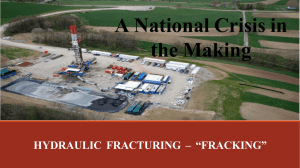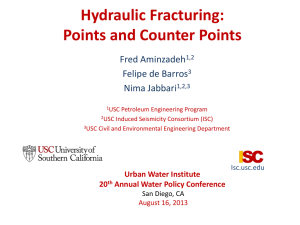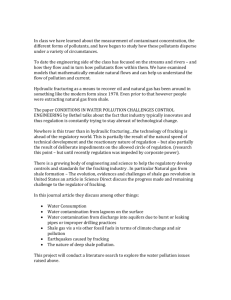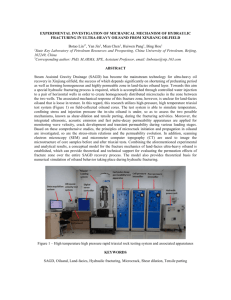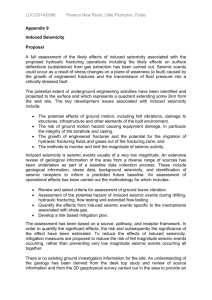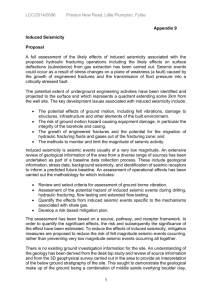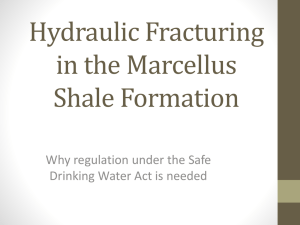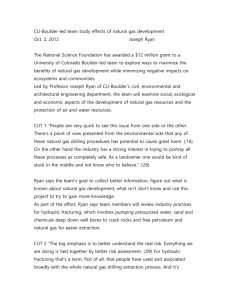LCC/2014/0101Roseacre Wood, Roseacre and Wharles, Fylde
advertisement
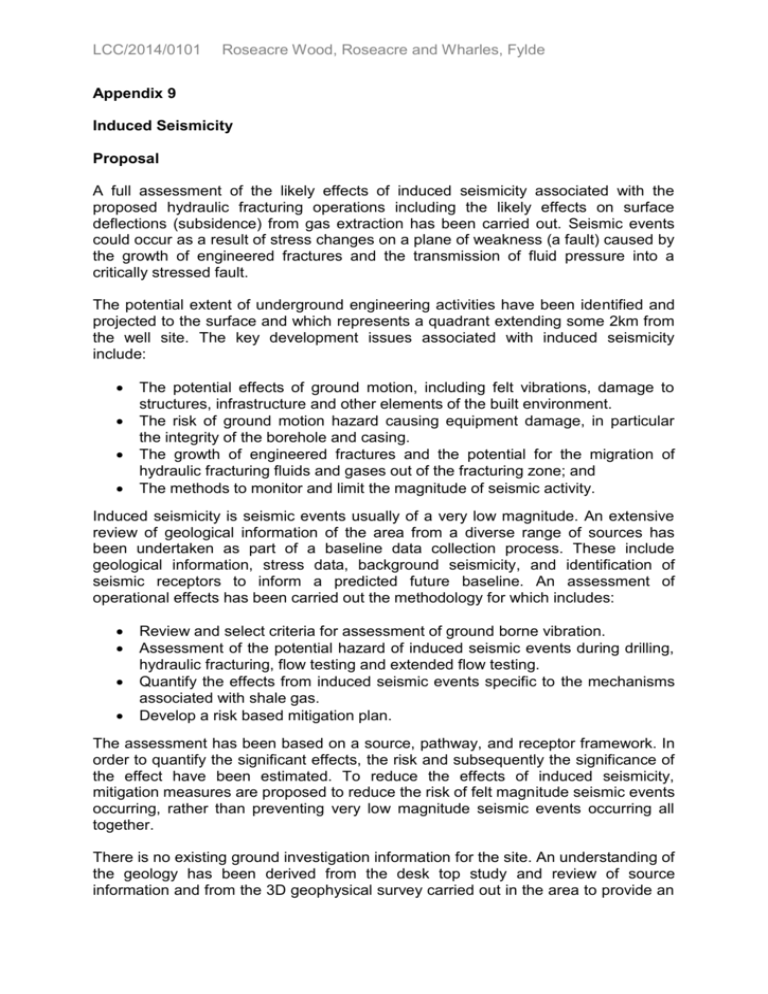
LCC/2014/0101 Roseacre Wood, Roseacre and Wharles, Fylde Appendix 9 Induced Seismicity Proposal A full assessment of the likely effects of induced seismicity associated with the proposed hydraulic fracturing operations including the likely effects on surface deflections (subsidence) from gas extraction has been carried out. Seismic events could occur as a result of stress changes on a plane of weakness (a fault) caused by the growth of engineered fractures and the transmission of fluid pressure into a critically stressed fault. The potential extent of underground engineering activities have been identified and projected to the surface and which represents a quadrant extending some 2km from the well site. The key development issues associated with induced seismicity include: The potential effects of ground motion, including felt vibrations, damage to structures, infrastructure and other elements of the built environment. The risk of ground motion hazard causing equipment damage, in particular the integrity of the borehole and casing. The growth of engineered fractures and the potential for the migration of hydraulic fracturing fluids and gases out of the fracturing zone; and The methods to monitor and limit the magnitude of seismic activity. Induced seismicity is seismic events usually of a very low magnitude. An extensive review of geological information of the area from a diverse range of sources has been undertaken as part of a baseline data collection process. These include geological information, stress data, background seismicity, and identification of seismic receptors to inform a predicted future baseline. An assessment of operational effects has been carried out the methodology for which includes: Review and select criteria for assessment of ground borne vibration. Assessment of the potential hazard of induced seismic events during drilling, hydraulic fracturing, flow testing and extended flow testing. Quantify the effects from induced seismic events specific to the mechanisms associated with shale gas. Develop a risk based mitigation plan. The assessment has been based on a source, pathway, and receptor framework. In order to quantify the significant effects, the risk and subsequently the significance of the effect have been estimated. To reduce the effects of induced seismicity, mitigation measures are proposed to reduce the risk of felt magnitude seismic events occurring, rather than preventing very low magnitude seismic events occurring all together. There is no existing ground investigation information for the site. An understanding of the geology has been derived from the desk top study and review of source information and from the 3D geophysical survey carried out in the area to provide an LCC/2014/0101 Roseacre Wood, Roseacre and Wharles, Fylde interpretation of the below ground stratigraphy of the site. This sought to demonstrate the geological make up of the ground being a combination of middle sands overlying boulder clay, Sherwood sandstone, Manchester marls, Collyhurst Sandstone, Millstone grit, upper and lower Bowland shales, Hodder mudstone and Clitheroe Limestone. The site is located within the Bowland Basin predominately active in the Carboniferous period 300 – 360 million years ago. Within the basins are a series of regional extensional faults the largest of which is the Woodsfold Fault which outcrops at the surface approximately 3k east of the site and dips approximately west beneath the site and some 650m below the shale gas target geological horizon. It has been assumed as a worst case scenario that all faults within the area of the well site are critically stressed although this is not always the case. Using a worst case scenario means that the mechanism of transmitting an increase in fluid pressure to a fault plane and hence induced seismicity is considered to be feasible for all faults that are critically orientated. A study of such would be carried out as part of the initial well drilling and used to prepare the fracking plan to be submitted to DECC for approval prior to any fracking being carried out. In terms of natural seismicity the UK is not a particularly active seismic region but is considered to have a low to moderate rate of seismicity. Within the UK, West Lancashire is interpreted to be a relatively low seismicity region. BGS records a magnitude of 3.7ML, a 4.7ML every 10 years and 5.6ML every 100 years. Currently the BGS earthquake catalogue does not contain information on events less than 2.0ML although it is expected that over 2000 events at 0.5M L occur every year in the UK. 0.5ML is the red light threshold in the Governments traffic light system mitigation measure. Consequently the applicant considers that the events associated with Preese Hall well site at 2.3 and 1.5ML were within the range of magnitudes commonly felt across the UK and which are not unusual in occurring every year in significant numbers. To assist in monitoring back ground seismicity an array of 4 monitors were installed at the Becconsall site, some 15km south of Blackpool and recorded background seismicity over a 6 month period. The monitoring recorded two natural seismic events which were also recorded by BGS, one near Ludlow (2.8ML) and one near Wigan (1.6ML) demonstrating natural seismicity near the Fylde. . The results from modelling with all the data compiled indicate that the maximum likely magnitude of induced seismic events associated with fracking would exceed the levels of Preese Hall if no mitigation measures were employed and injection volumes used at the time were to be used again. It is not proposed to inject similar volumes as part of the proposed operations and therefore the anticipated events would be significantly lower. An assessment of the impacts on the following receptors has been made: Wells – including the site exploration well and other wells. Infrastructure – including roads, railway, bridges, utilities, pipelines. Special buildings – including listed buildings, schools, hospitals, churches, monuments, stately homes, listening stations. Residential buildings. Industrial/commercial buildings. LCC/2014/0101 Roseacre Wood, Roseacre and Wharles, Fylde Hydraulic fracturing will cause induced seismicity. An assessment of ground motion hazard and other seismic related effects such as liquefaction, slope stability and subsidence has been carried out. The assessment on ground motion concludes that no damage to structures is anticipated and there would not be significant effect at levels up to 1.5ML although seismic events may be perceptible to some people in sensitive environments. The effects on well integrity at this level is considered to be not significant as is the effects on liquification potential, slope stability, settlement from gas extraction, earthquakes from gas extraction, fluid migration and changes in the stress regime, or effects on ground motion hazard causing salt cavern instability at the proposed Preesall Saltfield Underground Storage Project. For the prescribed levels to be exceeded, it would necessitate fluids to be injected to the same levels as at Preese Hall, for the traffic light system to fail or fluid transmitted into a fault. It is expected that the mitigation measure will be employed to prevent a level of 3.1ML being exceeded. If it were reached then it is expected vibrations could be felt up to 65km away, minor cosmetic damage to local sensitive structures, rare minor damage to the most sensitive civil infrastructure with no damage anticipated to reinforced buildings. However, the likelihood of such a level being generated is considered to be very low with medium consequences and the risk of magnitude no significant. As part of the initial flow testing there is likelihood that residual seismic events would be experienced but not in excess of those caused by fracturing. It is not anticipated that such events would be felt at the surface but would be recorded as part of the monitoring. This would similarly be the case for any extended flow testing and therefore any risk is expected to be negligible and not significant. With regard to cumulative and interactive effects in the event the site at Preston New Road is operationally active, this is considered to minor and not significant for both fracturing operations and flow and extended flow testing. To ensure that the limits of movement are not exceeded it requires the implementation of a traffic light system which utilises the data collected by the surface seismic monitoring array, the application for which is reported elsewhere on this agenda. This system wood be required to be employed by DECC. Green level is where pumping of fracking fluids would continue providing that induced seismicity is less than 0ML; if an event occurs in the amber range of 0ML to 0.5ML while pumping fracturing fluids the stage can be completed and the flow back procedure would be initiated. If an event were to occur in the red range while pumping the fracture stage would be aborted and the flow back procedure would be initiated. Throughout this process results would have to be submitted to DECC and would inform future operations. An assessment has also been carried out to determine whether the extraction of shale gas could cause settlement of the ground surface. The assessment acknowledges that settlement from extractive hydrocarbon industries has occurred in the past by either: 1. Removing large quantities of rock, for example in the coal industry; or LCC/2014/0101 Roseacre Wood, Roseacre and Wharles, Fylde 2. Removing liquid and gas in pore spaces between the rock causing the rock to consolidate, for example in the oil and gas industries. The assessment recognises that settlement, and more importantly deflection, of the ground surface can cause architectural and structural problems to buildings, services and infrastructure. However, shale gas production does not involve remove rock from underground and therefore the first potential mechanism for causing settlement would not occur. The second potential mechanism for causing settlement, consolidation or compaction due to extraction of liquids and gas, will not occur because the amount that shale rock changes with the extraction of gas is expected to be almost zero. In addition, it is noted that the ground surface is some 2.5 to 3km or more above the target reservoir, the horizontal wells in the shale will be no more than 8.5 inches in diameter, and the fractures created are equivalent in size to a grain of sand. The assessment concludes that there is no mechanism for the extraction of gas to cause deflection of the ground surface and notes that the proposal is an exploration well and is not (at present) planned for full scale production. As such there is no plan to extract any great quantity of gas, just to investigate the possible rates of gas flow in the Bowland Basin. Therefore, the risk that the extraction of shale gas will cause deflection of the ground surface during exploration at the Site is considered to be so low as to be negligible. Subject to the employment of such mitigation it is concluded that there would not be any risk unacceptable levels of seismic movements occurring associated with the hydraulic fracturing process. Policy and Guidance In terms of European legislation EIA is required for deep drilling projects and surface installations for the extraction of oil or gas to assess all relevant environmental risks including seismic hazard. In the UYK all petroleum licences are owned by the Crown and the right to exploit them is governed by DECC. DECC has adopted a traffic light system based on the recommendations of a number of bodies including The Royal Society and The Royal Academy of Engineering. The traffic light system requires monitoring by remote seismometers buried at the surface or at depth to undertake real time monitoring as part of the hydraulic fracturing process to inform, the duration and intensity of fluid injection during hydraulic fracturing stages to ensure that prescribed limits of induced seismicity are not exceeded – 0.5ML – the red light threshold to be used to limit induced seismicity to below the level that may be felt by humans. There are no policies relating to seismicity in the NPPF, the Joint Lancashire Minerals and Waste Development Plan or the Fylde Local Plan. In terms of guidance there have been numerous documents and publications but the following are considered most relevant for the purposes of seismicity: LCC/2014/0101 Roseacre Wood, Roseacre and Wharles, Fylde DCLG - Planning practice guidance for onshore oil and gas - provides advice on the planning issues associated with the three phases of extraction of hydrocarbons. It identifies the key regulators for hydrocarbon extraction including DECC who issues Petroleum Licences, gives consent to drill under the Licence once other permissions and approvals are in place, and have responsibility for assessing risk of and monitoring seismic activity, as well as granting consent to flaring or venting. Seismic assessment of the geology of the area to establish the geological conditions, risk of seismic activity and mitigation measures to put in place is required by the DECC for all hydraulic fracturing processes; The Royal Society: Shale gas extraction in the UK: a review of hydraulic fracturing June 2012 – The UK Government’s Chief Scientific Adviser asked the Royal Society and the Royal Academy of Engineering to carry out an independent review of the scientific and engineering evidence relating to the technical aspects of the risks associated with hydraulic fracturing to inform government policymaking about shale gas extraction in the UK. The terms of reference of this review were: What are the major risks associated with hydraulic fracturing as a means to extract shale gas in the UK, including geological risks, such as seismicity, and environmental risks, such as groundwater contamination? Can these risks be effectively managed? If so, how? With regard to seismicity the review recognises concerns about seismicity induced by hydraulic fracturing. Advises that Natural seismicity in the UK is low by world standards. On average, the UK experiences seismicity of magnitude 5 ML (felt by everyone nearby) every twenty years and of magnitude 4 ML (felt by many people) every three to four years. The UK has lived with seismicity induced by coal mining activities or the settlement of abandoned mines for a long time. British Geological Survey records indicate that coal mining-related seismicity is generally of smaller magnitude than natural seismicity and no larger than 4 ML. Seismicity induced by hydraulic fracturing is likely to be of even smaller magnitude. There is an emerging consensus that the magnitude of seismicity induced by hydraulic fracturing would be no greater than 3 ML (felt by few people and resulting in negligible, if any, surface impacts). Recent seismicity induced by hydraulic fracturing in the UK was of magnitude 2.3 ML and 1.5 ML (unlikely to be felt by anyone). The risk of seismicity induced by hydraulic fracturing can be reduced by traffic light monitoring systems that use real-time seismic monitoring so that operators can respond promptly. Monitoring should be carried out before, during and after shale gas operations to inform risk assessments. Methane and other contaminants in groundwater should be monitored, as well as potential leakages of methane and other gases into the atmosphere. The geology of sites should be characterised and faults identified. Monitoring data should be submitted to the UK’s regulators to manage potential hazards, inform local planning processes and address wider concerns. Monitoring of any potential leaks of methane would provide data to assess the carbon footprint of shale gas extraction. In particular the review considers that vibrations from a seismic event of magnitude 2.5 ML are broadly equivalent to the general traffic, industrial and other noise experienced daily and sets out the average annual frequency of seismic events in the UK in the following table: LCC/2014/0101 Magnitude (ML) Roseacre Wood, Roseacre and Wharles, Fylde Frequency in the UK Felt effects at the surface -3.0 -2.0 -1.0 0.0 1.0 Not detected by BGS’ network Not detected by BGS’ network Not detected by BGS’ network Not detected by BGS’ network 100s each year 2.0 25 each year 3.0 3 each 4.0 1 every 3-4 years 5. 0 1 every 20 years Not felt Not felt Not felt Not felt Not felt, except by a very few under especially favourable conditions. Not felt, except by a Very few under especially favourable conditions. Felt by few people at rest or in the upper floors of buildings; similar to the passing of a truck. Felt by many people, often up to tens of kilometres away; some dishes broken; pendulum clocks may stop. Felt by all people nearby; damage negligible in buildings of good design and construction; few instances of fallen plaster; some chimneys broken. The assessment concludes that the health, safety and environmental risks associated with hydraulic fracturing (often termed ‘fracking’) as a means to extract shale gas can be managed effectively in the UK as long as operational best practices are implemented and enforced through regulation. Hydraulic fracturing is an established technology that has been used in the oil and gas industries for many decades. The UK has 60 years’ experience of regulating onshore and offshore oil and gas industries. The review made 10 recommendations. Recommendation 3 is most pertinent to mitigate seismicity: BGS or other appropriate bodies should carry out national surveys to characterise stresses and identify faults in UK shales. Operators should carry out site-specific surveys to characterise and identify local stresses and faults. Seismicity should be monitored before, during and after hydraulic fracturing. Traffic light monitoring systems should be implemented and data fed back to well injection operations so that action can be taken to mitigate any induced seismicity. DECC should consider how induced seismicity is to be regulated. Operators should share data with DECC and BGS to establish a national database of shale stress and fault properties so that suitable well locations can be identified. LCC/2014/0101 Roseacre Wood, Roseacre and Wharles, Fylde Summary of Consultee comments and Representations The Director of Public Health has undertaken a HIA on the two drill sites and identified that the key risks to health and wellbeing of the population from the two proposed sites are a lack of public trust and confidence in the regulatory process and the industry, stress and anxiety from uncertainty about the industry that could lead to poor mental wellbeing; potential noise related health effects due to continuous drilling for at least five months for the initial borehole on each site and for three months for each of the subsequent three boreholes per site (14 months of continuous drilling), and potential health risks due to the presence of mining wastes generated as part of the drilling and hydraulic fracturing process being retained on site if adequate off site treatment facilities are not found. A number of key recommendations to inform the planning process have been made and for the purposes of seismicity include the need to: Undertake an independent verification of the assessment of air quality, transport, waste management and induced seismicity prior to determining the planning applications. A number of aims of the assessment include the need to: To establish an independent, reliable, single source of local information on shale gas exploration in Lancashire. As part of the objectives, the HIA recommends the need to: To develop a framework to establish a baseline and ongoing monitoring of environmental and health conditions. And with regard to data collection and analysis (an indicative list), this should include: Characterisation of the extent of fracture propagation and the permeability of layers above and beyond the faults Whilst the EA is a statutory consultee and DECC and the HSE has been consulted, they have not provided any specific advise or comments on the potential impacts of seismicity. As part of the scoping opinion provided by the County Council earlier in 2014 the County Council appointed specialist seismologists to advise what should be included in the EIA relating to seismology. The seismologists have undertaken a review of the EIA in terms of seismology and following the clarification of a number of issues with the applicant are satisfied that the proposed mitigation and adherence to national requirements would ensure that induced seismicity would not cause unacceptable impacts. A number of conclusions are drawn and recommendations made as summarised below: With a sensitive, buried array of monitoring instruments (e.g. in 100m boreholes), then it is highly likely that many more small magnitude induced events would be detected than the number felt by people. However, this is not LCC/2014/0101 Roseacre Wood, Roseacre and Wharles, Fylde the normal situation, which is to detect events using distributed regional monitoring stations that are sometimes supplemented with additional local stations, on the surface, following the initial occurrence of mining events. The BGS catalogue of UK earthquakes (covering the many natural ones as well as induced) shows that a few hundred coal mining induced events have been felt over the past 40 years. These events have been fairly common in UK coalfields where the local communities have largely accepted small tremors as not being a particular nuisance except where, on rare occasions, one has been of greater than magnitude 2.0ML. These mining events occur generally at very shallow depths of 0.5 to 1.0km, so are felt, for low magnitudes, as people are close to the energy source. In addition to the proposed monitoring, consideration should be given to establishing a plan to conduct macroseismic surveys for any events that residents report they feel. Some will be spurious (e.g. a lorry really was passing), others may be genuine as there is a small probability of exceeding the peak ground motions predicted and even a small probability of exceeding the 1.5ML “maximum” event on occasion. The data collected would help to calibrate predictions, and the exercise would be reassuring and provide the opportunity to explain that damaging events are not in the offing. BGS report that small natural earthquakes are commonly felt – on average, 23 each month somewhere in the country. During fracking and fluid flow at a geothermal project in Cornwall felt, induced events were very rare. Only one was felt by residents (2.0ML) with another only by staff working at the drilling site (0.7ML). The BGS local, surface array detected more than 1000 which were not felt, and the projects’ downhole instruments detected many thousands. The actions already taken as reported in the Statement of Community Involvement are supported as are those proposed through the continuation of the Community Liaison Group and various public lines of communication throughout the projects. It is recommend that, in addition to the efforts made and those proposed for the future, consideration be given to establishing a plan to conduct macroseismic surveys for any events that residents report they feel. Some will be spurious (e.g. a lorry really was passing); others may be genuine as there is a small probability of exceeding the peak ground motions predicted and even a small probability of exceeding the 1.5ML “maximum” event on occasion. The data collected would help to calibrate predictions, and the exercise would be reassuring and provide the opportunity to explain that damaging events are not in the offing. Calculating the probability of exceeding the 1.5ML scenario earthquake is difficult, and the likelihood of such an occurrence is a small possibility. If there were to be an event at that level, the impacts would be low; no damage but perhaps a low level of nuisance to a few people. The strengthening of twoway communications with residents would allay concerns; i.e. conveying more information about any felt and establishing a rapid response to anything reported felt. It is accepted that there will be continuous recording and no breaks, regardless of the level of operations, throughout the whole of the exploratory period. This will ensure that when the number of minor, instrumentally detected events falls to, or near to, zero, there will be objective evidence to demonstrate this and to learn from the patterns of seismicity associated with different phases of the operations. It is understood that battery consumption is LCC/2014/0101 Roseacre Wood, Roseacre and Wharles, Fylde higher during fracking operations (in order to achieve real-time communications), and drops between those operations but without compromising data collection. DECC has advised that the proposed activities include hydraulic fracturing for shale gas and that they require the operator to produce Environmental Risk Assessments, taking account of guidance published to the industry by DECC in April 2014, which flows from the recommendations of the Royal Academy of Engineering and the Royal Society, in their report on the hazards of hydraulic fracturing for shale gas published in June 2012. Drilling of wells requires Secretary of State consent under the terms of the licence and DECC will undertake a number of checks regarding well targeting and operator funds and insurance before giving consent. DECC also requires for hydraulic fracturing, the implementation of measures to mitigate seismic risk including the submission to DECC of a detailed Hydraulic Fracturing Programme (HFP) for each well to be hydraulically fractured. DECC will monitor the conduct of fracturing operations in accordance with the HFP. Proposals to flare gas during the initial testing phase will require the consent from the Secretary of State under the Energy Act 1976 and any venting is subject to DECC consent. Any venting should be reduced to a minimum. DECC's standard online drilling consent allows 96 hours of testing. To test for a longer period, the applicant will need to apply to DECC for a paper-based Extended Well Consent. DECC will expect the operator to minimise flaring during the period of any Extended Well Consent. Abandonment of any well requires the Secretary of State's consent under the terms of the licence. DECC will check for completeness of well data before giving consent. Many of the representations make reference to the risks associated with hydraulic fracturing and object to the proposals on this specific issue for the following summarised reasons: Potential and actual triggering of earth tremors the risk of which is not adequately addressed given past experience of test drilling in Fylde and could lead to injury to humans and wildlife. Strong risk earthquake in an unstable geology near to power nuclear power station at Heysham Fracking at Preese Hall caused earthquakes resulting in failure of the well, shaking and damage to properties - cracks in plaster, patio sinking, resulting in fear and anxiety. Undermines the surface strata causing sinkholes – growing evidence, risk of injuries/loss of life, property/town damage. Fracking test project – felt tremors in Poulton. There are too many local faults in national and local geology that are still moving and would act as pathways for the leakage of fluids. Earth movement happened in Lancashire as a result of initial testing – safety assurances are of no value. LCC/2014/0101 Roseacre Wood, Roseacre and Wharles, Fylde David Smythe, Professor of Geophysics at Glasgow University – research raised questions about dangers of fracking in UK. Induced seismic activity Link between fracking and previously geologically stable areas – Ohio/US. Intention is to drill into a fault line (fault 1) with Harves Ho and Moor Hey faults adjacent, will this induce seismic activity. Contrary to DECC guidance to avoid drilling wells into or close to existing pre stressed regional faults. Still not clear what happened at Preese Hall. Fracking could destabilise the entire bedrock beneath the Fylde, upon which sits several mine workings and unstable ground conditions – running sand etc. Fracking fluids migrating from wells near faults could lead to ground collapse releasing chemical slurry Fracking could cause risk to the proposed high pressure gas storage in salt caverns beneath Wyre estuary. PNR area moss land – significant risk to local properties of subsidence especially Carr Bridge Residential Caravan Park. Seismic monitoring will not stop the risk of earthquakes from the development Traffic light system of seismic monitors provides warning only, will not stop an earthquake. Earthquake risk –contrary to DM2. Annular pressure checks at Preese Hall are not independent. Assessment of Impacts Considerable concern has been expressed to the potential impacts of seismicity particularly in light of the apparently uncontrolled events associated with Preese Hall and the consequent risk of ground contamination associated with fracking fluids and gas as a result of migration from the geological horizon via the well and via unknown stressed fault lines. There is continued fear that induced seismicity will cause earthquakes and damage to properties and should not be permitted under private property without the consent of the landowner. There is a fear that there is insufficient understanding of the geology of the area and that fracking will cause irreparable damage both to the target geological horizon and potentially to those above and below it both in the short and long term that cannot be actually predicted. In view of these perceived fears considerable review and assessment of seismicity has been carried out, most particularly by The Royal Society which concludes that health, safety and environmental risks associated with hydraulic fracturing (often termed ‘fracking’) as a means to extract shale gas can be managed effectively in the UK as long as operational best practices are implemented and enforced through regulation. The review is clear that at 1.0ML there are 100s of natural seismic events in the UK and which are not felt, except by a very few people under especially favourable conditions. DECC will control fracking in a way, through a traffic light system that prevents fracturing generating more than 0.5ML. which means induced seismicity will not be felt at all, or only by a few under especially favourable conditions. Whilst perceived fears are understandable, they cannot be supported by independent review and guidance. It is safe to assume that BGS or other appropriate bodies will carry out national surveys to characterise stresses and identify faults in UK shales and operators will carry out site-specific surveys to characterise and identify local stresses and faults. It is proposed that seismicity will be monitored LCC/2014/0101 Roseacre Wood, Roseacre and Wharles, Fylde before, during and after hydraulic fracturing (see application LCC/2014/0102). Monitoring has already been carried out in the Becconsall area. A traffic light monitoring systems would be implemented and data fed back to well injection operations so that action can be taken to mitigate any induced seismicity and which would be overseen by DECC and whom the county council can be satisfied will operate within its own regulatory framework. With regard to possible subsidence DECC has reported ( Review and Recommendations for Induced Seismic Mitigation (April 2012) that there are no documented cases of fracturing operations causing subsidence or tremors large enough to cause damage at the surface and that unlike coal mining, shale gas production does not remove large quantities of rock from underground, which can cause subsidence. The report notes that subsidence can happen when rock is compressed and collapses in on itself, but that shale rock is not easily compressed, so subsidence is unlikely and that rock samples would be tested before any commercial production is approved. The conclusions of the applicant and the previous conclusions of DECC are accepted. It is considered that the proposed exploration and appraisal of shale gas would not lead to any subsidence at surface and should there be an opportunity for any further stage of exploration that could lead to commercial exploitation, that would require the benefit of planning permission and would be the subject of greater scrutiny by DECC. With regard to the representations received it is not likely that seismic activity would lead to injury to humans or wildlife or destabilise the geology in a way that would generate earthquakes that would place the Heysham power station or the proposed underground gas storage project at Preesall at risk. The County Council is not aware of any verified evidence of damage to property as a consequence of the seismic events at Preese Hall or that the surface strata was undermined in any way or present a risk of subsidence to moss land or nearby properties. There is no evidence to support that fact induced seismicity would led to pollution of surface or ground water or that the process could be safely carried out. A 3D survey has been carried out to give a clear understanding of the geological conditions and faulting in the area and the sites, depth and direction of drilling and horizons proposed to be fracked have been chosen and designed in a way to minimise seismic movement and which, if undertaken in accordance with a traffic light system would prevent the migration of fluids. There are no mine workings in the Fylde. With regard to specific points raised DECC has advised that faults should be avoided, whatever their scale where hydraulic fracturing is involved. From the viewpoint of seismic hazards, there is no need to be concerned about drilling through a fault, as opposed to hydraulically fracturing into or near a fault. Drilling, as such, is not in the experience of the oil industry an operation associated with seismic activity. DECC is not aware of any factor in the geology around the proposed drilling sites which should require avoidance of all faults, so far as the drilling phase of operations are concerned. It is maintained that the 3D seismic survey is inadequate in coverage, in particular because the proposed Roseacre drilling site is very near the edge of the survey area and the resolution of faults is consequently poor at that location. DECC considers that drilling through a fault does not entail any seismic hazard. The location of the LCC/2014/0101 Roseacre Wood, Roseacre and Wharles, Fylde site, or more precisely the trajectory of the initial vertical well, is not material to the adequacy of the 3D survey so far as seismic hazards is concerned. What matters is the resolution of faults available in the areas in which fracturing is proposed. A DECC geoscientist has reviewed Cuadrilla’s 3D data on a workstation at their office, and considers that the data quality is adequate in those areas to enable detection of all faults likely to be significant from the viewpoint of seismic hazard. DECC will scrutinise the Hydraulic Fracturing Plans (HFPS) and the plans for monitoring the growth of the fractures to ensure that the stimulated rock volume does not extend too close to any of the mapped faults. It is said that faults should be assumed to be transmissive unless proved otherwise. This comment is not directly relevant to seismic hazards; the purpose of the HFPs and their scrutiny by DECC is to ensure that the full extent of the stimulated rock volume preserves a safe distance from any detectable fault. The fracturing fluids will therefore never enter the fault, and will not be transmitted along it. It is said that Cuadrilla’s definition of faults is defective. However, the purpose of the definitions adopted is to distinguish between “local” faults, which Cuadrilla propose to drill through, and regional faults, which they do not intend to drill through. DECC does not see drilling through faults as material to the assessment of seismic risk. As to the location and extent of fracturing operations, which are very material, Cuadrilla plans to avoid all detectable faults, which is the correct approach. It is said that the current regulatory system is inadequate, in that no criteria have been specified in the “traffic light” system for shutting down operations, other than temporarily. DECC would not agree that this is a shortcoming. The association between hydraulic fracturing and seismic activity remains a relatively novel discovery and a developing area of knowledge. However, the data from the Preese Hall tremors indicate that careful monitoring of seismic activity in real time is likely to detect precursor events, providing scope to halt operations, reduce stresses, and avoid any more substantial tremor. That is the purpose of the traffic light system. But in the present state of knowledge, any predetermined protocol for action which should follow a red-light event would risk excessive precaution on the one hand, or avoidable disturbance to nearby residents on the other. DECC’s intention in any such instance is to explore the implications of the occurrence of the red-light event promptly but thoroughly, with a view to deciding whether operations can be resumed without undue risk of disturbance to local residents; and if so, what operations are acceptable and whether any further precautions are appropriate. DECC thinks this strikes an appropriate balance in present circumstances between precaution and protection and have no doubt that their powers are sufficient to curtail operations in any such case should it prove necessary. Whilst the concerns are understandable it is concluded that they cannot be supported and that the County Council can assume and be satisfied that the development would be carried out to meet the requirements of DECC. Conclusions LCC/2014/0101 Roseacre Wood, Roseacre and Wharles, Fylde It is concluded that induced fracturing will generate seismic movement but providing it is within the limits of a traffic light system it will not cause unacceptable impacts and would be overseen by DECC to ensure it would be carried out safely. It is considered that the proposed exploration and appraisal of shale gas would not lead to any subsidence at surface. It is therefore considered that the proposal would not have an unacceptable impact and would not be in conflict with the policies of the NPPF or the development plan policies.

